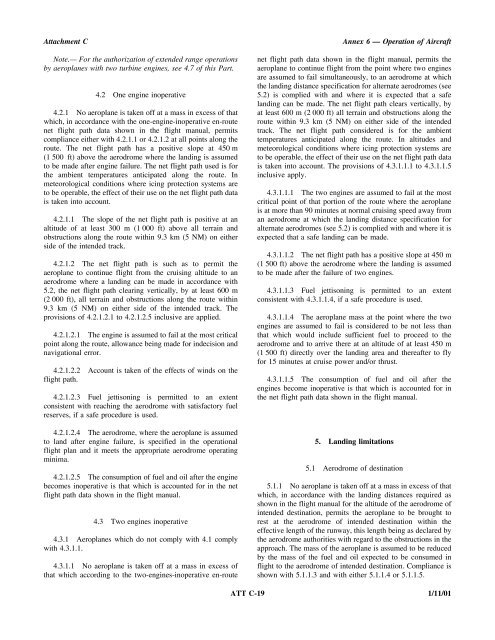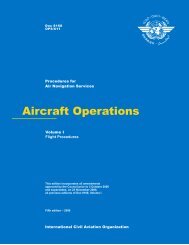Operation of Aircraft
Annex 6, Part I
Annex 6, Part I
- No tags were found...
Create successful ePaper yourself
Turn your PDF publications into a flip-book with our unique Google optimized e-Paper software.
Attachment C<br />
Note.— For the authorization <strong>of</strong> extended range operations<br />
by aeroplanes with two turbine engines, see 4.7 <strong>of</strong> this Part.<br />
4.2 One engine inoperative<br />
4.2.1 No aeroplane is taken <strong>of</strong>f at a mass in excess <strong>of</strong> that<br />
which, in accordance with the one-engine-inoperative en-route<br />
net flight path data shown in the flight manual, permits<br />
compliance either with 4.2.1.1 or 4.2.1.2 at all points along the<br />
route. The net flight path has a positive slope at 450 m<br />
(1 500 ft) above the aerodrome where the landing is assumed<br />
to be made after engine failure. The net flight path used is for<br />
the ambient temperatures anticipated along the route. In<br />
meteorological conditions where icing protection systems are<br />
to be operable, the effect <strong>of</strong> their use on the net flight path data<br />
is taken into account.<br />
4.2.1.1 The slope <strong>of</strong> the net flight path is positive at an<br />
altitude <strong>of</strong> at least 300 m (1 000 ft) above all terrain and<br />
obstructions along the route within 9.3 km (5 NM) on either<br />
side <strong>of</strong> the intended track.<br />
4.2.1.2 The net flight path is such as to permit the<br />
aeroplane to continue flight from the cruising altitude to an<br />
aerodrome where a landing can be made in accordance with<br />
5.2, the net flight path clearing vertically, by at least 600 m<br />
(2 000 ft), all terrain and obstructions along the route within<br />
9.3 km (5 NM) on either side <strong>of</strong> the intended track. The<br />
provisions <strong>of</strong> 4.2.1.2.1 to 4.2.1.2.5 inclusive are applied.<br />
4.2.1.2.1 The engine is assumed to fail at the most critical<br />
point along the route, allowance being made for indecision and<br />
navigational error.<br />
4.2.1.2.2 Account is taken <strong>of</strong> the effects <strong>of</strong> winds on the<br />
flight path.<br />
4.2.1.2.3 Fuel jettisoning is permitted to an extent<br />
consistent with reaching the aerodrome with satisfactory fuel<br />
reserves, if a safe procedure is used.<br />
4.2.1.2.4 The aerodrome, where the aeroplane is assumed<br />
to land after engine failure, is specified in the operational<br />
flight plan and it meets the appropriate aerodrome operating<br />
minima.<br />
4.2.1.2.5 The consumption <strong>of</strong> fuel and oil after the engine<br />
becomes inoperative is that which is accounted for in the net<br />
flight path data shown in the flight manual.<br />
4.3 Two engines inoperative<br />
4.3.1 Aeroplanes which do not comply with 4.1 comply<br />
with 4.3.1.1.<br />
4.3.1.1 No aeroplane is taken <strong>of</strong>f at a mass in excess <strong>of</strong><br />
that which according to the two-engines-inoperative en-route<br />
Annex 6 — <strong>Operation</strong> <strong>of</strong> <strong>Aircraft</strong><br />
net flight path data shown in the flight manual, permits the<br />
aeroplane to continue flight from the point where two engines<br />
are assumed to fail simultaneously, to an aerodrome at which<br />
the landing distance specification for alternate aerodromes (see<br />
5.2) is complied with and where it is expected that a safe<br />
landing can be made. The net flight path clears vertically, by<br />
at least 600 m (2 000 ft) all terrain and obstructions along the<br />
route within 9.3 km (5 NM) on either side <strong>of</strong> the intended<br />
track. The net flight path considered is for the ambient<br />
temperatures anticipated along the route. In altitudes and<br />
meteorological conditions where icing protection systems are<br />
to be operable, the effect <strong>of</strong> their use on the net flight path data<br />
is taken into account. The provisions <strong>of</strong> 4.3.1.1.1 to 4.3.1.1.5<br />
inclusive apply.<br />
4.3.1.1.1 The two engines are assumed to fail at the most<br />
critical point <strong>of</strong> that portion <strong>of</strong> the route where the aeroplane<br />
is at more than 90 minutes at normal cruising speed away from<br />
an aerodrome at which the landing distance specification for<br />
alternate aerodromes (see 5.2) is complied with and where it is<br />
expected that a safe landing can be made.<br />
4.3.1.1.2 The net flight path has a positive slope at 450 m<br />
(1 500 ft) above the aerodrome where the landing is assumed<br />
to be made after the failure <strong>of</strong> two engines.<br />
4.3.1.1.3 Fuel jettisoning is permitted to an extent<br />
consistent with 4.3.1.1.4, if a safe procedure is used.<br />
4.3.1.1.4 The aeroplane mass at the point where the two<br />
engines are assumed to fail is considered to be not less than<br />
that which would include sufficient fuel to proceed to the<br />
aerodrome and to arrive there at an altitude <strong>of</strong> at least 450 m<br />
(1 500 ft) directly over the landing area and thereafter to fly<br />
for 15 minutes at cruise power and/or thrust.<br />
4.3.1.1.5 The consumption <strong>of</strong> fuel and oil after the<br />
engines become inoperative is that which is accounted for in<br />
the net flight path data shown in the flight manual.<br />
5. Landing limitations<br />
5.1 Aerodrome <strong>of</strong> destination<br />
5.1.1 No aeroplane is taken <strong>of</strong>f at a mass in excess <strong>of</strong> that<br />
which, in accordance with the landing distances required as<br />
shown in the flight manual for the altitude <strong>of</strong> the aerodrome <strong>of</strong><br />
intended destination, permits the aeroplane to be brought to<br />
rest at the aerodrome <strong>of</strong> intended destination within the<br />
effective length <strong>of</strong> the runway, this length being as declared by<br />
the aerodrome authorities with regard to the obstructions in the<br />
approach. The mass <strong>of</strong> the aeroplane is assumed to be reduced<br />
by the mass <strong>of</strong> the fuel and oil expected to be consumed in<br />
flight to the aerodrome <strong>of</strong> intended destination. Compliance is<br />
shown with 5.1.1.3 and with either 5.1.1.4 or 5.1.1.5.<br />
ATT C-19 1/11/01












